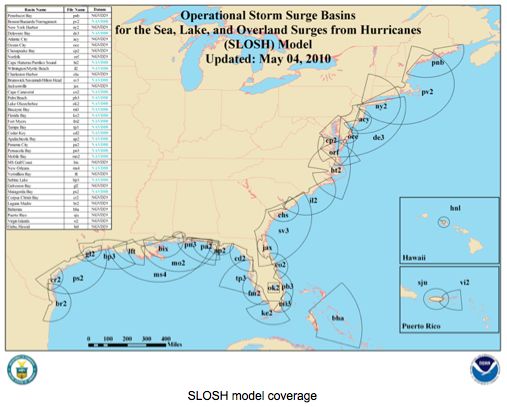 Climate Change & Infrastructure Resilience
Climate Change & Infrastructure Resilience
Climate Vulnerability Assessments for Coastal Washington County
The utility of a Climate Vulnerability Assessment (CVA) is not to predict the exact height of water or the date a storm will arrive – they cannot know this. Rather, property owners, municipal officials and first responders can use the town-and bay-specific scenarios in Washington County to review scenarios of possible impacts from severe storms. The scenarios use Geographic Information System (GIS) models that are based on a single modeled storm hitting Penobscot Bay; actual conditions depend on wind speed, direction, and the track of the storm, largely random variables.
Again, the CVAs describe possible impacts from severe storms. Their purpose is not to instill fear or alarm but to enable preparation and response.
Washington County Climate Vulnerability Assessment (11.7MB PDF) NOTE Town-Specific CVAs are under development for towns who attended the 5 bay-specific Climate Vulnerability Assessment meetings in the Fall of 2013
Each time a storm takes aim at Maine, we roll the dice. Most of the time, we win the toss and the conditions are such that we don't see major impacts. Sooner or later, we'll lose the toss. With climate change, we'll be rolling the dice more and more often (more storms), and the stakes will get higher (stronger storms). Add sea level rise to that, and you raise the stakes even more.
 Vermont and NYC have recently lost the toss. Neither place had seen a storm like Irene or Sandy in recorded history, but they could have predicted the impacts of those storms. In the case of Superstorm Sandy, the same National Weather Service SLOSH model that we use to prepare the scenarios for Washington County, accurately predicted that impacts seen in New Yok City.
Vermont and NYC have recently lost the toss. Neither place had seen a storm like Irene or Sandy in recorded history, but they could have predicted the impacts of those storms. In the case of Superstorm Sandy, the same National Weather Service SLOSH model that we use to prepare the scenarios for Washington County, accurately predicted that impacts seen in New Yok City.
SLOSH has been applied to the entire U.S. Atlantic and Gulf of Mexico coastlines. In addition, coverage extends to Hawaii, Puerto Rico, Virgin Islands, and the Bahamas. The SLOSH model coverage is subdivided into 37 regions or basins. These basins are centered upon particularly susceptible features: inlets, large coastal centers of population, low-lying topography, and ports.
The vulnerability of Washington County is high when we are eastward of a hurricane making landfall in Penobscot Bay because the highest winds are on the east side of the storm. High winds from the south drive storm surge up the long bays situated between our southern oriented peninsulas.
Storm Surge Scenarios in Washington County Towns
Please take our 5-minute User Feedback Survey — help us improve the online mapping tools and training resources — Thanks!
The links below provide access to the Storm Surge Scenario mapping resources.
Below are a set of links that provide access to the on-line GIS mapping tools in five bays across coastal Washington County. Users can connect to the bay that includes their area or town of interest and then interact with the mapping tool. Download the Storm Surge Scenarios Instructions here to explain how to change the base map, zoom to the area of interest, add or hide layers of interest (public facilities, infrastructure, vulnerable populations etc.), change storm intensity and tidal height, and add sea level rise.
Assumptions in Choice of Scenarios
The choice to depict the static maps with a Category 2 Hurricane and to post the on-line scenarios with an initial starting point of a Category 2 Hurricane (even though the scenarios can depict Categories 1 – 4) was based on the recent experience of Hurricane Irene (Category 1 when making landfall in New York and extratropical cyclone when hitting Vermont; August, 2011) and Hurricane AKA “Superstorm” Sandy (Category 2, 2012).
We assume that a Category 2 Hurricane making landfall at mean or high tide is a plausible and potentially damaging scenario for the Washington County coastline. The interactive scenarios allow a user to see the inundation associated with a Category 4 Hurricane but, as noted above, our intent is to inform and allow for preparation and adaptation, not to be alarmist or to focus on extreme or remotely probable events.
The addition of 3 feet of sea level rise is based on the mid-range estimate for the next 100 years from climate change scientists whose estimates vary from 1 to 6 feet of sea level rise by 2100.
If you have questions or comments on your experience using the maps or need some coaching/training on how to use them please contact Judy East or Tora Johnson.
Links to On-Line Interactive Storm Surge Scenario Tools
Please take our 5-minute User Feedback Survey — help us improve the online mapping tools and training resources — Thanks!
This first set of links to the interactive storm surge scenarios begin with a Category 2 Hurricane reaching shore at High Tide at current sea levels
NOTE: users can then change the scenarios to view Hurricane Categories of 1 through 4 at Mean or High tide
- Pleasant Bay (includes municipalities of Steuben, Milbridge, Harrington, Cherryfield, Columbia)
- Wohoa Bay (includes municipalities of Addison, Jonesport, Beals, Jonesboro)
- Machias Bay (includes municipalities of Machias, Machiasport, East Machias, , Roque Bluffs, Marshfield, Whiting, Cutler)
- Cobscook Bay (includes municipalities, unorganized territories and tribal community of Lubec, Trescott, Edmunds, Dennysville, Pembroke, Perry, Pleasant Point, Eastport)
- Upper St Croix Estuary (includes municipalities of Robbinston and Calais)
This second set of links to the interactive storm surge scenarios begin with a Category 2 Hurricane reaching shore at High Tide with 3 feet of sea level rise
NOTE: users can then change the scenarios to view Hurricane Categories of 1 through 4 at Mean or High tide
- Pleasant Bay (includes municipalities of Steuben, Milbridge, Harrington, Cherryfield, Columbia)
- Wohoa Bay (includes municipalities of Addison, Jonesport, Beals, Jonesboro)
- Machias Bay (includes municipalities of Machias, Machiasport, East Machias, , Roque Bluffs, Marshfield, Whiting, Cutler)
- Cobscook Bay (includes municipalities, unorganized territories and tribal community of Lubec, Trescott, Edmunds, Dennysville, Pembroke, Perry, Pleasant Point, Eastport)
- Upper St Croix Estuary (includes municipalities of Robbinston and Calais)
Download the Storm Surge Scenarios Instructions here
If you have questions or comments on your experience using the maps or need some coaching/training on how to use them please contact Judy East or Tora Johnson.

Share this content: